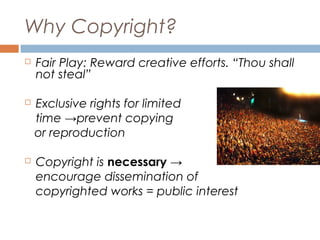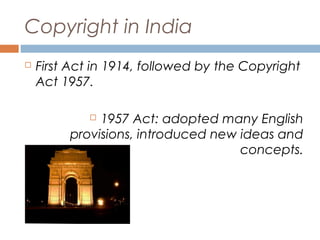Copyright in india
- 1. INTRODUCTION TO COPYRIGHT IN INDIA By Veeral Bhateja Contact me : +91-8741810758
- 2. Structure of the Presentation Three parts (1) Copyright in India (2) Infringement of Copyright (3) Case Study: Apple VS Samsung
- 3. What is Copyright? “The exclusive right given by law for a certain term of years to an author, composer etc. (or his assignee) to print, publish and sell copies of his original work” (Oxford English Dictionary)
- 4. Why Copyright? Fair Play: Reward creative efforts. “Thou shall not steal” Exclusive rights for limited time →prevent copying or reproduction Copyright is necessary → encourage dissemination of copyrighted works = public interest
- 5. England & Wales Indian copyright law similar to England & Wales. First Copyright Act in England (and the world) 1709 → Statute of Anne.
- 6. Indian Perspectives The Copyright Act 1957
- 7. Copyright in India First Act in 1914, followed by the Copyright Act 1957. 1957 Act: adopted many English provisions, introduced new ideas and concepts.
- 8. Copyright Act 1957 – Main Features Valid from 21 January 1958 Created Copyright Office and Copyright Board Introduced civil and criminal remedies against infringement
- 9. Copyright Act 1957 – Main Features (II) Performing rights societies (rights for instance, music royalties) Definition of categories in which copyright actually subsists International copyright Definition of infringement
- 10. Copyright (Amendment) Act 1983 and 1984 Objectives Berne and Universal Copyright Conventions grant of compulsory licenses by developing countries 1984 Act: discouraging and preventing widespread video piracy.
- 11. Copyright (Amendment) Act 1992 Defined ambit of the Copyright Board’s powers Introducing special rights for performers Assignment and licenses of copyright Rights of copyright owners
- 12. What Copyright Protects Original Literary, Dramatic, Musical and Artistic Works Cinematograph Films Sound Recordings
- 13. Literary Works Novels, poems, short stories Books on any subject Computer programmes, tables, computer databases Song lyrics
- 14. Computer Software Includes Programme Manuals Punched Cards Magnetic Tapes/Discs Computer printouts Computer programmes
- 15. Infringement of Copyright When (Copy)right becomes wrong
- 16. Statutory Definition Copyright Act 1957 Infringement: exercising rights of the copyright owner Making, distributing, exhibiting and importing infringing copies of the work
- 17. Factors Determining Infringement Copying Causal Connection Subconscious Copying Indirect Copying Substantial Taking Unaltered copying Extent of defendant’s alteration Character of Plaintiff’s and Defendant’s works Nature and Extent of Plaintiff’s Effort
- 18. Apple VS Samsung This case was filed on April 15 2011
- 19. Case Highlights Apple sued its component supplier Samsung, alleging in a 38-page federal complaint on April 15, 2011 in the United States District Court for the Northern District of California that several of Samsung's Android phones and tablets, including the Nexus S, Epic 4G, Galaxy S 4G and the Samsung Galaxy Tab, infringed on Apple’s intellectual property: its patents, trademarks, user interface and style. Apple's complaint included specific federal claims for patent infringement, false designation of origin, unfair competition, and trademark infringement, as well as state-level claims for unfair competition, common law trademark infringement, and unjust enrichment.
- 20. Final Verdict As a result of the combination of a sophisticated jury that understood the nuances of intellectual property law and abundant evidence of copying by Samsung, Apple was awarded $1.049 billion in its patent infringement lawsuit on Aug. 24, 2012. The jury was apparently swayed by evidence that Samsung had copied Apple’s iPhone models that led to a jury verdict that six Apple patents were found to be infringed.




















